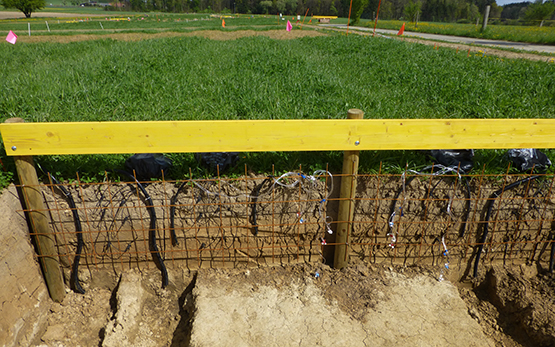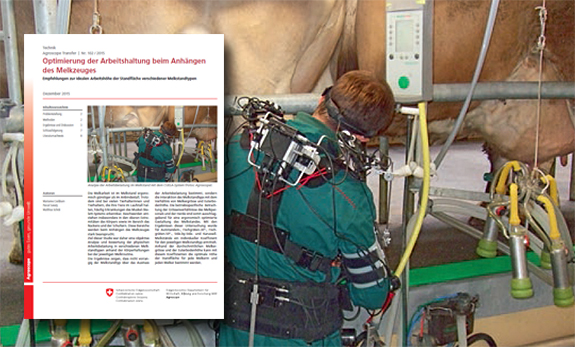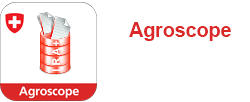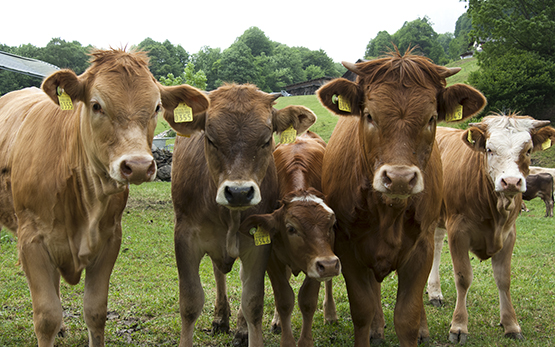Kiesbauer J., Kölliker R., Hug M., Sindelar M., Schlatter L. H., Ohnmacht J., Studer B., Grieder C.
Higher seed yield through selection for reduced seed shattering in Italian ryegrass.
Crop Science, 65, (1), 2025, Artikel e70002.
Skot L., Nay M. M., Grieder C., Frey L. A., Pégard M., Öhlung L., Amdahl H., Radovic J., Jaluvka L., Palmé A., Ruttink T., Lloyd D., Howarth C. J., Kölliker R.
Including marker x environment interactions improves genomic prediction in red clover (Trifolium pratense L.).
Frontiers in Plant Science, 15, 2024, 1-18.
Hiltbrunner J., Gustodis G., Kessler HG., Klein S., Kölliker R., Loschi M., Müller N., Narciso JO., Ramseier H., Rumler R., Schmid T., Schönlechner R., Suarez DA., Vonlanthen T.
Millet research in Switzerland and millet processing into products other than dehulled grains and flakes.
In: International Millet Conference : Promoting Millet throung interdisciplinary research: New varieties and new markets for a better Tomorrow!. 1-3 August, Hrsg. University of Nebraska-Lincoln, Rutgers University, North American Millets Alliance (eds: Dipak Santra and Sanjib Bhuyan), Gering,. 2023, 21-22.
Kiesbauer J., Grieder C., Studer B., Kölliker R.
Perspectives for reducing seed shattering in ryegrasses.
Grass and Forage Science, 78, (4), 2023, 425-437.
Nay M. M., Grieder C., Frey L. A., Amdahl H., Radovic J., Jaluvka L., Palmé A., Skøt L., Ruttink T., Kölliker R.
Multi-location trials and population-based genotyping reveal high diversity and adaptation to breeding environments in a large collection of red clover.
Frontiers in Plant Science, 14, 2023, 1-17.
Kiesbauer J., Grieder C., Schlatter L. H., Chen Y., Studer B., Kölliker R.
A major QTL for stem rust resistance in Italian ryegrasses explains 53% of the phenotypic variation.
Bulletin SGPW-SSA, 32, 2022, 22.
Frey L., Vleugels T., Ruttink T., Grieder C., Studer B., Kölliker R.
Untersuchung der Resistenz gegen den südlichen Stängelbrenner und den Kleekrebs in unterschiedlichen Rotklee Populationen.
Bulletin SGPW-SSA, 32, 2022, 15.
Huguenin-Elie O., Studer B., Kölliker R., Reheul D., Probo M., Barre P., Feuerstein U., Roldán-Ruiz I., Mariotte P., Hopkins A.
Improving sown grasslands through breeding and management: Proceedings of the Joint 20th Symposium of the European Grassland Federation and the 33rd Meeting of the EUCARPIA Section ‘Fodder Crops and Amenity Grasses’, Zürich, Switzerlan, 24-27 June 2019.
European Grassland Federation EGF, W. Kessler, Federation Secretary, c/o Agroscope, Zurich, Switzerland. 2019, 558 S.
Lüscher A., Grieder C., Huguenin-Elie O., Klaus V.H., Reidy B., Schneider M. K., Schubiger F., Suter D., Suter M., Kölliker R.
Grassland systems in Switzerland with a main focus on sown grasslands.
Grassland Science in Europe, 24, 2019, 3-16.
Mueller-Harvey I., Bee G., Dohme-Meier F., Hoste H., Karonen M., Kölliker R., Lüscher A., Niderkorn V., Pellikaan W.F., Salminen J.-P., Skøt L., Smith L.M.J., Thamsborg S.M., Totterdell P., Wilkinson I. und weitere
Benefits of condensed tannins in forage legumes fed to ruminants: Importance of structure, concentration, and diet composition.
Crop Science, 59, (3), 2019, 861-885.
Ahrens C., Frey J. E., Irmler S., Kölliker R., Pelludat C., Weisskopf L., Widmer F.
Schlussbericht Agroscope Forschungsprogramm Mikrobielle BioDiversität.
Agroscope, Bern. Januar, 2018, 50 S.
Kölliker R., Boller B.
Plant breeding: the art of bringing science to life: Abstracts of the 20th EUCARPIA General Congress 29 Aug - 1 Sep 2016.
Agroscope, Institute for Sustainability Sciences ISS, ETH Zurich, Switzerland. 2016, 460 S.
Last L., Boller B., Widmer F., Kölliker R.
Influence of management and habitat on genetic and phenotypic diversity of Dactylis glomerata: Chapter 12.
In: Quantitative Traits Breeding for Multifunctional grasslands and turf. Dordrecht, Hrsg. Sokolovic et al. , Springer Science+Business Media. 2014, 91-95.
Isobe S., Kölliker R., Boller B.
Red clover (Trifolium pratense L.): Chapter 11.
In: Genetics, Genomics and Breeding of Forage Crops. Boca Raton, FL, USA, Hrsg. H. Cai, T. Yamada, & C. Kole , CRC Press. 2014, 220-249.
Kölliker R., Last L., Herzog F., Widmer F.
Genetische Diversität in der Landwirtschaft.
Agrarforschung Schweiz, 5, (1), 2014, 12-19.
weitere Sprachen:
französisch
Last L., Lüscher G., Widmer F., Boller B., Kölliker R.
Indicators for genetic and phenotypic diversity of Dactylis glomerata in Swiss permanent grassland.
Ecological Indicators, 38, 2014, 181-191.
Birrer M., Kölliker R., Manzanares C., Asp T., Studer B.
A DNA marker assay based on high-resolution melting curve analysis for distinguishing species of the Festuca–Lolium complex.
Molecular Breeding, 34, (2), 2014, 421-429.
Last L., Arndorfer M., Balázs K., Dennis P., Dyman T., Fjellstad W., Friedel J., Herzog F., Jeanneret P., Lüscher G., Moreno G., Kwikiriza N., Gomiero T., Paoletti M., Pointereau P. und weitere
Indicators for the on-farm assessment of crop cultivar and livestock breed diversity: a survey-based participatory approach.
Biodiversity and Conservation, 23, (12), 2014, 3051-3071.
Last L., Widmer F., Fjellstad W., Stoyanova S., Kölliker R.
Genetic diversity of natural orchardgrass (Dactylis glomerata L.) populations in three regions in Europe.
BMC Genetics, 14, (1), 2013, 1-13.
Wichmann F., Vorhölter F.-J., Hersemann L., Widmer F., Blom J., Niehaus K., Reinhard S., Conradin C., Kölliker R.
The noncanonical type III secretion system of Xanthomonas translucens pv. graminis is essential for forage grass infection.
Molecular Plant Pathology, online, 2013, 1-13.









